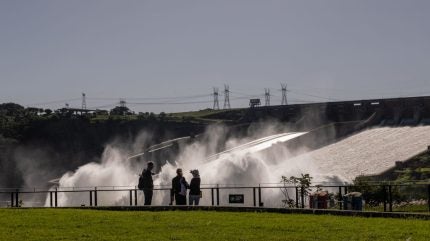
Brazil switched off two of its largest hydroelectric power plants last week due to a severe drought.
On Wednesday (7 August), the Electric Sector Monitoring Committee (CMSE) advised the Brazilian government to minimise hydropower usage and shift its focus to thermal sources as well as import electricity from Argentina and Uruguay, citing low water levels in the River Madeira.

Discover B2B Marketing That Performs
Combine business intelligence and editorial excellence to reach engaged professionals across 36 leading media platforms.
According to Brazil’s National Water Agency, the current conditions are set to last until 30 November.
Brazil is the second-largest producer of hydroelectricity in the world, according to the World Economic Forum (WEF). Power Technology’s parent company, GlobalData, reports that the country recorded 41GW of hydropower generation in 2023.
The country was expected to continue high levels of hydro generation this year with large amounts of water secured in its dams, but the drought on the river Madeira, which has been an issue since mid-2023, has remained a hurdle.
The global hydro crisis
Brazil is not the only country to experience this crisis; droughts have led to a significant drop in hydropower generation worldwide.

US Tariffs are shifting - will you react or anticipate?
Don’t let policy changes catch you off guard. Stay proactive with real-time data and expert analysis.
By GlobalDataChina is the global leader in hydropower output. However, droughts have contributed to the decline of hydropower generation in the country since 2021. Despite its hydro capacity increasing by 7.8% between 2021 and 2023, hydropower generation did not see the same increase, registering 1,184 terawatt-hours (TWh) in 2021, 1,202TWh in 2022 and 1,141TWh in 2023, according to the WEF.
The International Energy Agency (IEA) confirmed that China’s hydropower generation fell by 4.9% in 2023, stating that the country’s generation would have been 125TWh higher if its hydropower fleet availability had been the same as 2022.
The US, another hydro powerhouse, suffered a 6% decrease in hydropower generation in 2023 due to significant water loss in the north-west from high global temperatures that halted production at its hydropower plants.
The IEA highlighted that the global shortfall in hydropower generation due to droughts drove up global emissions by around 170 tonnes last year as countries had to revert to conventional sources to meet their energy demands.
A potential solution: grid development
To combat the effect of droughts on hydropower, the WEF suggested removing regulatory barriers and providing significant financial support to develop an interconnected grid.
Brazil has benefitted from this solution.
Other nations have turned to fossil fuels when droughts affected their hydro generation. Brazil, on the other hand, has been able to easily switch to other renewable sources or access rain from other parts of the country thanks to its fully interconnected grid.
While droughts have hindered, and are expected to continue hindering, Brazil and the world’s hydroelectricity generation, continued development of electricity infrastructure is likely to help minimise the consequences.





